Many observers agree that OpenAI started an A.I. arms race. While the 2,158 AI tools listed on GPTE.ai are not indicative of the state of the real generative AI market, there is no question that soon there will be far more than two thousand generative AI tools.
Right now, every entrepreneur and his sister are looking to retool their current offering to add generative AI to their feature list. Or better yet, play Silicon Valley’s favorite game — do a hard pivot and become an AI company.
An estimate of the true size of the generative AI market is provided by Dealroom.co researchers Felix Ullmer and Lorenzo Chiavarini who found about 250 such companies.
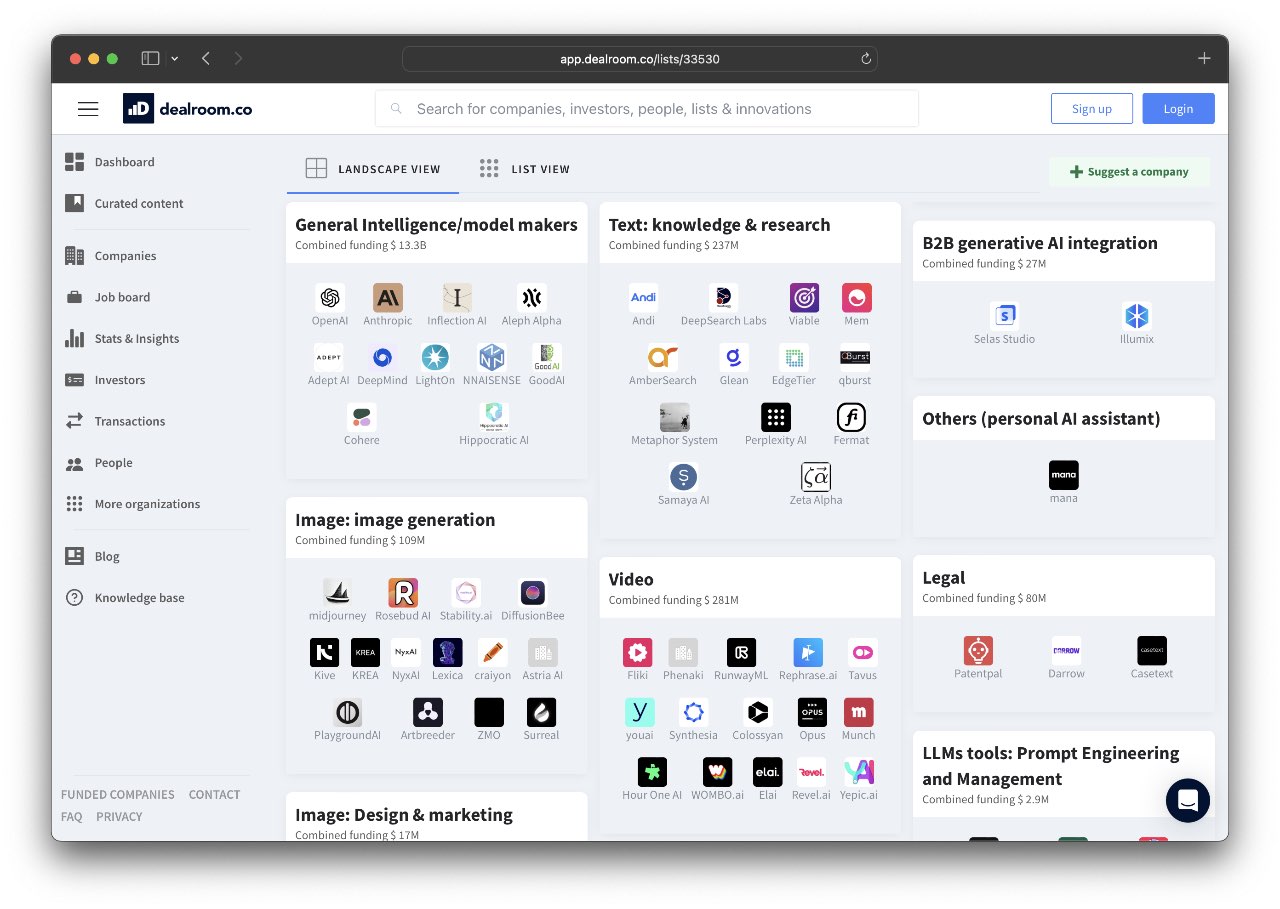 Dealroom.co offers a well-organized listing of companies who ply their trade in the generative AI space. They estimate that at least 250 companies have a relationship with this market segment.
Dealroom.co offers a well-organized listing of companies who ply their trade in the generative AI space. They estimate that at least 250 companies have a relationship with this market segment.
Chatbots
ChatGPT
OpenAI is a leading company in the A.I. space, focusing on developing cutting-edge technologies like GPT-3 and DALL-E. Their AI-based tools like ChatGPT and Whisper AI are helping businesses automate tasks and improve efficiency. For much more background info on ChatGPT, see Generative AI Will Shape-Shift Our Future in a Profound Way. Right now, ChatGPT is the best general AI tool.
It’s free to use but for the best possible experience, upgrade to ChatGPT Plus for $20/mo. However, despite that extra fee, and ready access to GPT-4, keep in mind that ChatGPT Plus is still limited:
”GPT-4, like its predecessors including GPT-3 and the model you’re currently communicating with, does not have a direct connection to the internet to access or retrieve real-time information. It generates responses based on a mixture of licensed data, data created by human trainers, and publicly available data. Its knowledge is based on the text it was trained on, and it can’t access or retrieve personal data unless it has been shared with it during the conversation.
Its responses are generated based on patterns and information in the data it was trained on. If it is asked about events or information updated after its last training cut-off (September 2021 in this case), it would not be able to provide that information.
To obtain current or real-time information, it’s recommended to use search engines, official websites, or relevant authorities. OpenAI’s priority is to ensure user safety and privacy, and thus real-time internet connection capabilities are not part of the model’s design.”
— ChatGPT Plus
06-Jun-23
Microsoft Bing
Microsoft offers another version of ChatGPT but Microsoft now requires that users install the Edge browser to use the new Bing. If you already use that browser, that’s fine, but if not, you’re better off using the real thing.
Bard
Google’s Bard is in its current state an also-ran. Despite Alphabet’s massive expenditures on A.I., the company was caught with its pants down by OpenAI. A fact documented in a leaked internal document called “ We Have No Moat, And Neither Does OpenAI.” Here’s a highly relevant quote:
”But the uncomfortable truth is, [Alphabet is not] positioned to win this arms race, and neither is OpenAI. While we’ve been squabbling, a third faction has been quietly eating our lunch.”
— SemiAnalysis
04-May-23
Besides these three general AI tools, there are many more that specifically focus on certain applications or market segments. Here are some of the most important ones, listed in alphabetical order:
Coding
Coding tools powered by generative AI offer significant efficiency gains for developers. However, some tech leaders express concern about the negative impact of producing excessive code too quickly. On the other hand, many companies are optimistic about the potential of generative AI to automate specific aspects of the code-writing process, leading to substantial productivity improvements.
GitHub Copilot
In 2022, Microsoft released GitHub Copilot, which aims to use AI to help you write code. Microsoft, GitHub and OpenAI are being sued in a class action lawsuit that accuses them of violating copyright law by allowing Copilot, a code-generating system, to regurgitate sections of licensed code without providing credit. (Copilot was co-developed by OpenAI and GitHub, which Microsoft owns.)
Hugging Face
Hugging Face develops tools for building applications that use machine learning. It is best known for its platform that lets users share machine learning models and datasets and a transformers library built for natural language processing (NLP) applications. Another popular Hugging Face tool is the Diffusion Bias Explorer, which compares generated image sets to detect AI system bias.
Blink Copilot
Blink CEO Gil Barak identifies three distinct phases in the evolution of security operations automation. In the first phase, experts had to manually code workflows, a time-consuming process that took several weeks or even months to produce a single workflow. Then came low-code techniques that allowed users to drag and drop components into a workflow, automating most of the coding process and significantly speeding up the workflow creation process. Generative AI has ushered in a third era of security operations automation, letting users describe a workflow and have the platform build it for them using a tool like Blink Copilot. Now users can automate the creation of security workflows based on the development of large language models (LLMs).
Collaborative Applications
Otter.ai
Otter.ai’s AI-powered chatbot automatically handles live note-taking and action-item tracking. To use it, log into their Otter account and connect to Google or Microsoft calendars. OtterPilot then automatically joins your meetings and takes notes, even if you’re not in the meeting yourself. OtterPilot lets those annoying people who come to meetings late ask “I’m late to the meeting! What did I miss?” The free version includes 300 monthly minutes of notetaking, or up to 30 minutes per conversation. The $16.99-a-month Pro version is better suited for longer meetings. The feature is available via web, iOS, and Android apps.

OtterPilot is the transcription service’s version of ChatGPT. I takes notes, tracks action items and allows latecomers to ask, “What did I miss?”
Zoom IQ
In March, Zoom expanded its Zoom IQ assistant with AI-power meeting summaries and prompt-based email responses. A Zoom Pro account is required, which costs $150/yr.
Event Planning
Eventbrite
Event management and ticketing website Eventbrite has launched new GPT-powered tools to help event creators with the most tedious and time-consuming steps in event planning — event pages, email campaigns and social media ads. Users can now create an Eventbrite event page with automatically generated event descriptions and images that are based on event title, location and date. It also fills in event type, category and sub-category, making it easier for people to discover events.
The new copywriting feature for social media ads is only available to subscribers of Boost — a marketing platform that uses machine learning to target audiences on Facebook and Instagram. Boost has three tiers — Lite ($15/mo.), Core ($50/mo.) and Pro ($100/mo.).
Image Generation
There are three major categories of AI image tools, text-to-image generation, photo manipulation, and photo editing. In the former category are tools like Adobe Firefly, DALL-E, Midjourney and starryai, which can all create an image based on a text prompt. Photo manipulation tools, on the other hand, use existing images and add backgrounds or special effects. This category also includes Adobe Firefly, in addition to FaceApp, Try It On and Virtual Face. Finally, some apps, AI photo editors, use AI to refine or repair images, including MyHeritage, Pixelmator and Topaz Labs.
Both text-to-image and photo manipulation tools can produce images that feature people with appearances and characteristics that aren’t real. Photo manipulation tools use generative AI to turn photos initially captured with smartphones and cameras into something that never was. Generative AI also allows these apps to take headshots and create convincing new images generated from thin air.
Photoshop artists have been manipulating photos like this for decades, but advancements in AI image models now allow Joe Six Pack to do it too. You can read more about these new photo tools in Joanna Stern’s recent review in The Wall Street Journal.
Adobe Firefly
On Mar. 21, 2023, Adobe launched its own AI image generator, Adobe Firefly, a “family of creative generative AI models,” currently consisting of four tools:
- Text to image – This feature works like DALL-E or Midjourney, allowing users to type in a prompt and have an image created in return.
- Generative fill – Use a brush to remove objects or paint in new ones.
- Text effects – Generates stylized text, kind of like an AI-powered WordArt.
- Generative recolor – Generates color variations of vector artwork from a detailed text description.
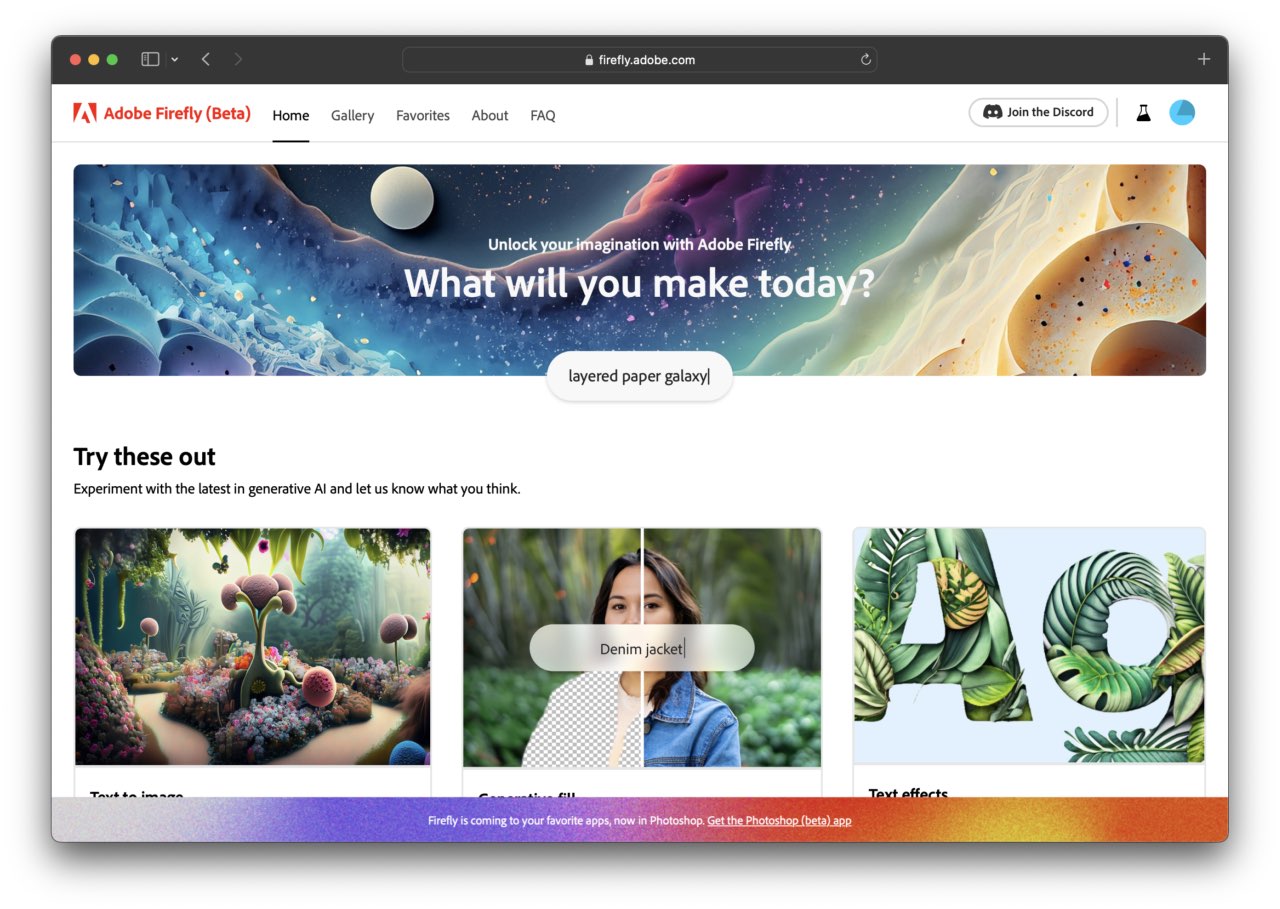 The Adobe Firefly text-to-image tool sports an elegant user interface but despite millions of dollars available for research, it still suffers from the same “bad hand syndrome” as the competition.
The Adobe Firefly text-to-image tool sports an elegant user interface but despite millions of dollars available for research, it still suffers from the same “bad hand syndrome” as the competition.
DALL-E
While AI-driven systems that can generate art date back to the late 1960s, it was OpenAI’s January 2021 introduction of its text-to-image generator DALL-E that opened the floodgates. In May 2022, the company launched DALL-E 2. One outstanding feature of DALL-E 2 is outpainting, which helps users extend an image beyond its original borders using the same patterns contained in the original image.
All AI image generators suffer from a vexing problem. They are unable to properly render a hand. Within AI datasets, human images show hands less visibly than faces, which, when combined with the complicated geometry of hands, means generative AI systems cannot rely on a universal collection of lines or shapes to identify a hand. An example is provided below.
 The DALL-E image on the left illustrates the “bad hand syndrome.” Now compare that to the image of a beautiful nymph on the right created by starryai. Wait a minute, what’s wrong with her eyes? And is that a big cold sore above her lips? As you can see, there are still challenges with generative AI images.
The DALL-E image on the left illustrates the “bad hand syndrome.” Now compare that to the image of a beautiful nymph on the right created by starryai. Wait a minute, what’s wrong with her eyes? And is that a big cold sore above her lips? As you can see, there are still challenges with generative AI images.
Midjourney
Midjourney is generally acknowledged to be the best AI text-to-image generator. Unfortunately, Midjourney is not a real application but a total hack that requires users to visit the Midjourney community on Discord, assuming they have an account, and post their prompts in a special thread. It’s as user-unfriendly as they come.
StarryAI
starryai is an AI text-to-image generator that lets you enter a prompt in its web application. The art generator then transforms your words into works of art. starryai also offers an avatar creator, which produces what it calls “starrytars.”
Virtual Face
Virtual Face is a photo manipulator that offers users the “perfect” corporate headshot created with AI. Submit five photos, and Virtual Face’s advanced algorithm creates 56 variations that capture your “true essence.”
Topaz Labs
Topaz Labs uses an AI algorithm to sharpen images. A before-and-after image comparison provided by the company is featured on our home page.
Try It On
Photo manipulator Try It On offers users AI-enhanced social media profile and corporate headshots for $17.
Google Product Studio
Google is launching Product Studio, a new tool that allows Google Shopping merchants to edit and customize product images for free using generative AI. Product Studio is rolling out to U.S.-based sellers in “the next few months,” a process that will be completed in 2024. It will be hosted by Merchant Center Next, the company’s redesigned platform for uploading and advertising products through Google Shopping.
According to Google, product listings with more than one image typically see a 76% increase in impressions and a 32% increase in clicks compared to listings with a single image. Product Studio was designed to help sellers diversify product and lifestyle images used on e-commerce listings.
Learning
Duolingo
Duolingo Max uses a GPT-4 Roleplay chatbot that offers French and Spanish learners on iOS a more engaging experience than the language-learning app’s often-repetitive exercises. Each Roleplay conversation follows a theme like a fictional Caribbean holiday, part of 100 initial scenarios. The bot corrects errors and uses a more advanced vocabulary for each response. Duolingo’s content experts programmed its AI language model to address learners as a language instructor and only discuss the present scenario. As a result, no two conversations are alike, and Roleplay gets more advanced as learners progress. Roleplay is available as a part of the Duolingo Max subscription plan that costs $30 a month or $168 annually.
 Duolingo Roleplay allows learners to practice real-world conversation using a GPT-4-based chatbot through different scenarios, such as discussing future vacation plans, ordering coffee at a café in Paris, or going furniture shopping.
Duolingo Roleplay allows learners to practice real-world conversation using a GPT-4-based chatbot through different scenarios, such as discussing future vacation plans, ordering coffee at a café in Paris, or going furniture shopping.
Khanmigo
Khan Academy’s Khanmigo virtual tutor offers personalized homework help and subject-themed quizzes. Khanmigo has several personalized learning tools, including a “Tutor me” mode and a quiz module for different subjects.
While ChatGPT can readily provide a ready-made essay, Khanmigo is programmed not to provide the entire answer, instead responding with probing questions, like, “Can you think of other examples?”
Khan Academy used tutoring research to create its prompts. For example, when students get frustrated, it can offer stronger hints. To address concerns about wrong answers, Khan Academy worked with OpenAI to make GPT-4 better in certain disciplines, like math.
Productivity
Canva
Canva has integrated generative AI throughout its product suite. It currently offers three AI tools, all free: a text-to-image generator, Magic Write — a text generator and writer; plus Magic Design — an AI design tool.
As the video above shows, Canva’s Magic Write, powered by OpenAI, is an AI text generator that helps users draft documents using prompts to write copy, create blog outlines and lists, and generate captions, content ideas, and brainstorms.
Mem
Your work and life is scattered across your brain and across hundreds of different apps. Mem imports old notes, syncs your email and calendar, save links and websites, and centralizes your knowledge. To find what you need, simply starting a conversation with Mem. There are red flags like this cautionary note from The Verge:
“The most ambitious version of the product will require a huge amount of work and a lot of technology that either doesn’t exist or only barely works. It will require partnerships with huge tech firms that may be reticent to share their data, trust from users who have to compile it all together, and a user experience that is infinitely flexible without being too complicated or overwhelming.”
— The Verge
01-Feb-23
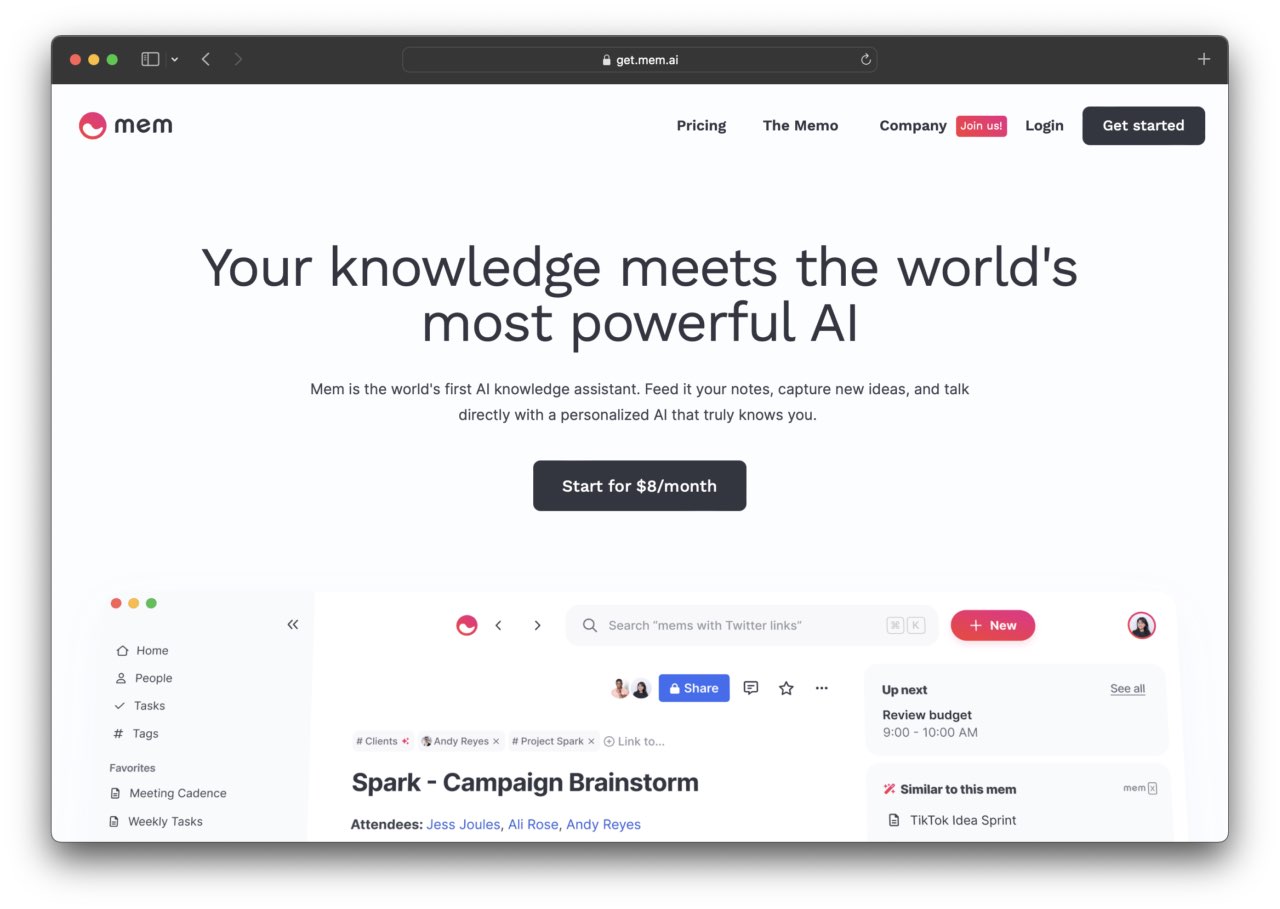 Mem is a billed as an “AI knowledge assistant” that aims to be for much more than notes. It uses AI to store all your personal information and then make it easily accessible.
Mem is a billed as an “AI knowledge assistant” that aims to be for much more than notes. It uses AI to store all your personal information and then make it easily accessible.
Notion AI
Notionis an all-in-one productivity application that lets you take notes, manage tasks, organize databases, set up wikis, and collaborate with team members. In November, Notion started testing a new AI offering, but now it’s available to anyone with an account.
While Notion AI can help write articles with little input, the company bills it more as a “thought partner.” Notion AI can also help summarize an article or notes, generate a task list based on selected text, and do translations.
In its announcement, Notion said one of the features testers used the most was asking it to improve written text. Typically, you would highlight text and ask Notion to rewrite it in a different tone, use simpler language, or simply pad out or cut down a sentence.
Like ChatGPT, Notion AI appears limited to events before September 2021, but Notion says it’s working with multiple partners, including OpenAI and Anthropic. Notion AI is available as an add-on to Notion plans, including Free Plans, for $10/month.
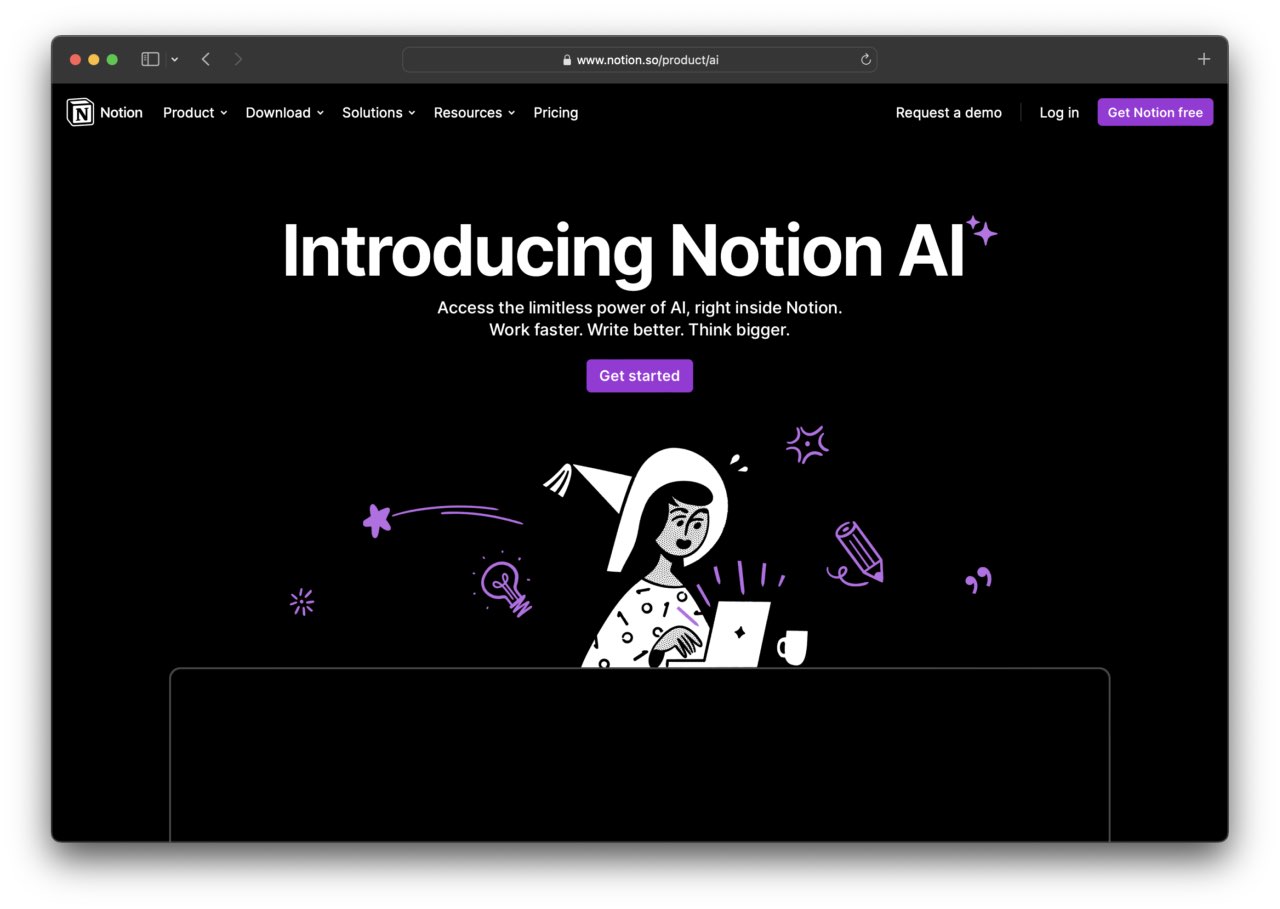 This is what Notion’s copywriters came up with, “Access the limitless power of AI, right inside Notion. Work faster. Write better. Think bigger.” Enuff said.
This is what Notion’s copywriters came up with, “Access the limitless power of AI, right inside Notion. Work faster. Write better. Think bigger.” Enuff said.
Rewind.ai
Much like mem, Rewind.ai is a personal search engine that knows everything about meetings, tasks, browser history, email, and everything else. Sounds super helpful, but to some, it’s like a terrifying hellscape dystopia. 😁
Rewind.ai calls its AI feature “ChatGPT For Me” — a GPT-4 chatbot that you interact with to sift through the information Rewind.ai collects about you.
There are two tiers: free or $30/mo. Unfortunately, we found that Rewind was not particularly good at unearthing critical stuff, and wonder if the addition of GPT-4 would only confuse matters further. Besides, when we deleted Rewind from our 2021 MacBook Pro, it freed up 68 GB of data, and we had only been using Rewind for a few months. This particular MBP has a 4TB SSD, but for people with less capacity, Rewind.ai could quickly present a storage issue.
Lindy
The chatbots are definitely coming for your stuff. Lindy is another AI assistant that CEO Flo Crivello hilariously described to The Verge as “ChatGPT with access to all your apps.” Concludes the publication, “…the real trick is making that work without compromising your privacy.”
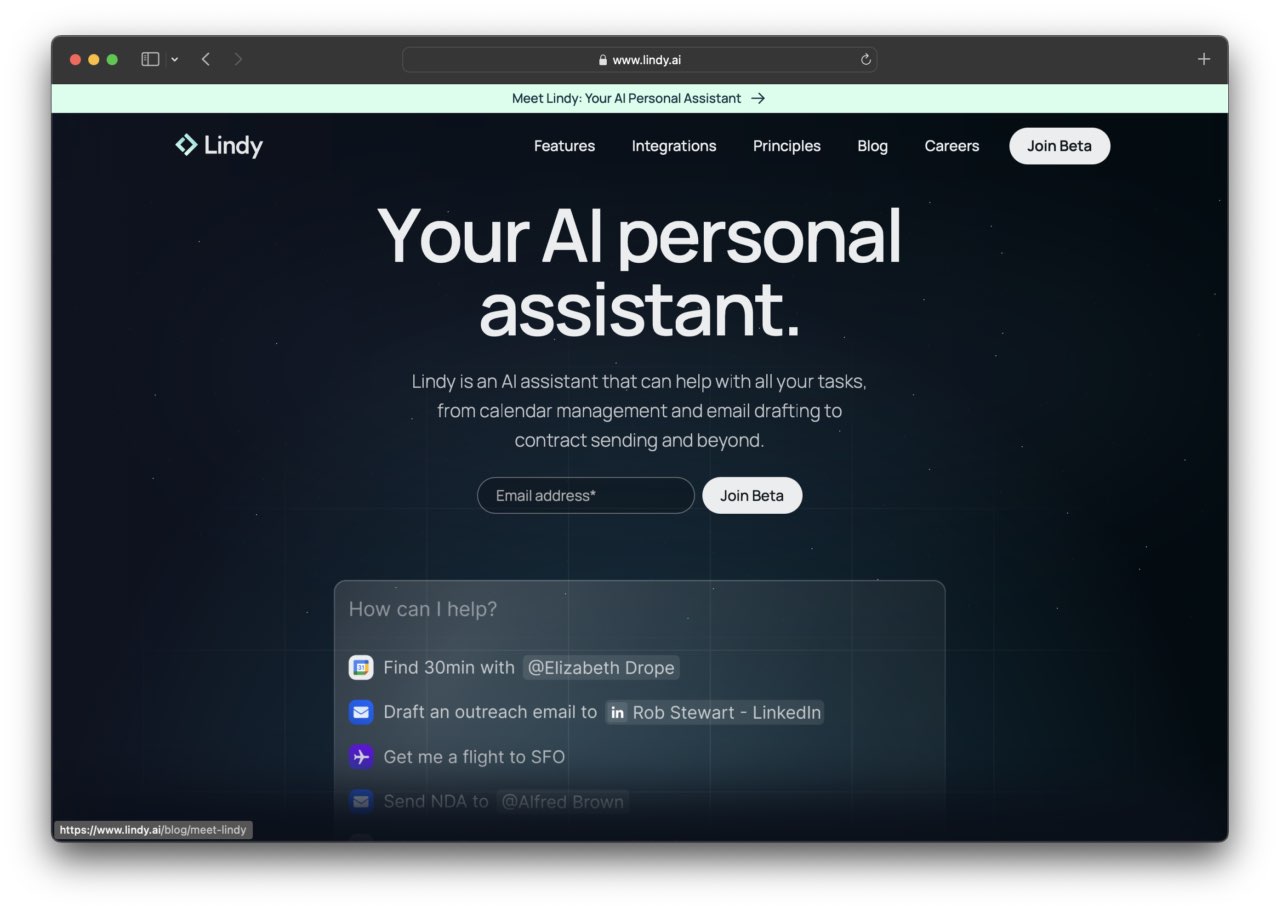 Lindy is an AI assistant that helps with typical user tasks, from calendar management, to email drafting to sending contracts.
Lindy is an AI assistant that helps with typical user tasks, from calendar management, to email drafting to sending contracts.
Social Media
Snapchat My AI
Introduced in February 2023 and initially exclusive to Snapchat+ subscribers, “My AI” is now available to everyone. According to Snap, Snapchat+ subscribers have been enjoying an AI-powered chatbot that allows them to learn about movies, sports, pets, and other topics. NOT!
It turns out that despite boasting a friendlier tone and reportedly producing more succinct answers than ChatGPT, Snapchat My AI has reportedly been the subject of degrading, gaslighting, and emotional tormenting.
Originally designed to recommend meals or gift ideas, Snapchat’s bot is able to discuss a wide range of topics, from aches and pain to a definitive ranking of Beyoncé’s albums. The Snapchat bot does recommend resources when it detects conversations about sensitive topics. For example, discussing anxiety or other personal struggles could prompt a mental-health resource.
The AI feature is controversial among users, searches for “delete Snapchat” rose after its February release. One reason may be that only paying Snapchat+ subscribers can unpin it.
Travel Planning
Expedia ChatGPT (plugin or iOS app only)
While The Wall Street Journal reported a positive experience using Expedia’s ChatGPT feature to plan travel, Tom’s Guide said it “ didn’t go well.”
KAYAK ChatGPT Plugin
Tom’s Guide reported a much better experience with KAYAK’s ChatGPT plugin. It should be noted that plugins require both a ChatGPT Plus subscription and activating a beta feature from an OpenAI drop-down menu. This process is not particularly user-friendly. The publishers of the plugin AskYourPDF have created a nice tutorial on installing plugins.
Utilities
GPTZero.com
If you need to check whether a passage was written by AI, you can check it by when entering the text in question into the AI text classifier tool GPTZero.com.
Orginality.ai
Accurate AI & Plagiarism Detector for Serious Content Publishers. According to a recent roundup by Elegant Themes, Originality.ai is the best AI detection tool who reports that “It’s a favorite among users for its ability to swiftly and accurately identify AI-generated content, ensuring the authenticity and originality of written material.”
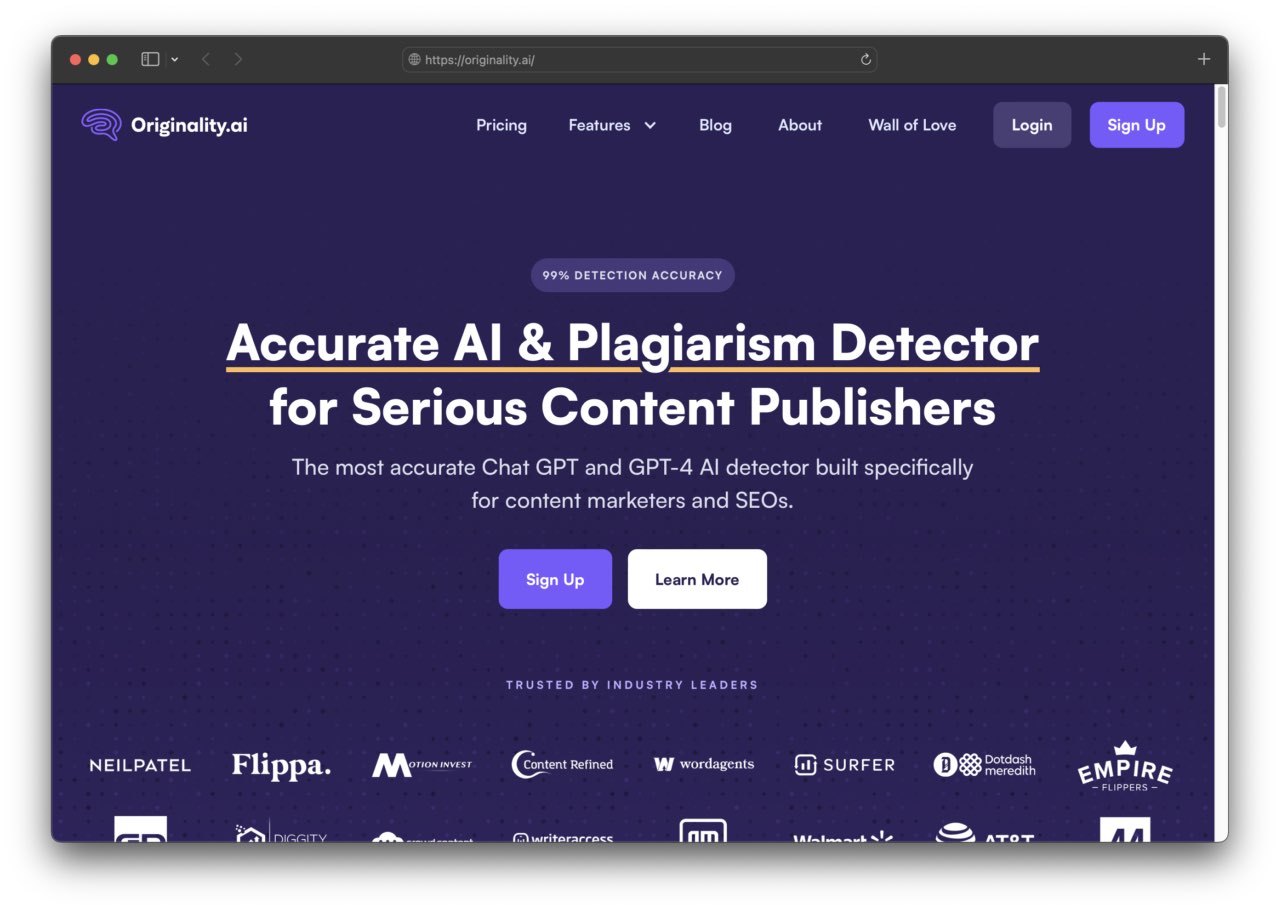 Originality.ai claims it’s “the most accurate Chat GPT and GPT-4 AI detector built specifically for content marketers and SEOs.”
Originality.ai claims it’s “the most accurate Chat GPT and GPT-4 AI detector built specifically for content marketers and SEOs.”
Video
Some of the biggest companies in tech are researching text-to-video. Meta has announced Make-A-Video, Google introduced Imagen Video, and Phenaki and Nvidia are about to get involved.
None of these projects are available for public use. And the output of these systems leaves a lot to be desired: figures warp and morph, and there are obvious changes between frames. But the demos provide the inkling of an exciting text-to-video future.
Becca Farsace has a great review of the latest video tools: “ Five AI tools creators should know.”
Meta Make-A-Video
AI text-to-image generators have been making headlines in recent months, but researchers are already moving on to the next frontier: AI text-to-video generators. Meta’s Make-A-Video lets users type in a rough scene description, generating a short video matching their text. According to The Verge, “the videos are clearly artificial, with blurred subjects and distorted animation.”
Meta has not provided access to the model used by each video shown to the press. The clips could have been cherry-picked to show Make-A-Video in its best light. That also means that, like most of Meta’s announcements, Make-A-Video is vaporware. We only included it here because, if it works, it would represent a significant step forward in AI content generation.
Synthesia
Synthesia.io is an AI video creation tool that allows users to create professional videos by transforming text into video in as little as 15 minutes. Synthesia can convert speech into 120+ different languages, and you can choose from more than 140 diverse “AI Avatars,” which are really virtual personalities, like “Natalie” shown below.
![]() Synthesia dispenses with actors, cameras, and studios, to help users create explainer videos with ready-to-use AI Avatars, like Natalie shown above, and voiceovers in 120+ languages. You can edit and update your videos whenever needed.
Synthesia dispenses with actors, cameras, and studios, to help users create explainer videos with ready-to-use AI Avatars, like Natalie shown above, and voiceovers in 120+ languages. You can edit and update your videos whenever needed.
QuickVid
QuickVid combines several generative AI systems into a single tool for automatically creating short-form YouTube, Instagram, TikTok and Snapchat videos. QuickVid’s website proclaims users can create YouTube Shorts 10 times faster with A.I. Given a single-word prompt (automatically extracted from the script or entered manually), QuickVid will:
- Text-to-video – Generate a script leveraging the generative powers of GPT-3.
- Background – Choose a background video from the royalty-free stock media library Pexels.
- Overlay images – Generate overlay images with DALL-E 2 and add a synthetic voiceover and background music from YouTube’s royalty-free music library.
- Voiceover – Output the voiceover via Google Cloud’s text-to-speech API before combining all elements into a video. Users will soon be able to clone their voice for voiceovers.
QuickVid’s creator, Daniel Habib, says the company is building a service that helps creators meet the “ever-growing” demand from fans. QuickVid costs $10/mo.
Voice
BanterAI
BanterAI is an innovative online platform that offers users a catalog of more than 50 renowned experts and celebrities from various fields. For $5 a month, BanterAI subscribers can have unlimited conversations with bots that sound like Kim Kardashian, Billie Eilish and Steve Jobs. BanterAI also offers mobile chat and calling features.
Descript Overdub
Descript Overdub lets you create a text-to-speech model of your voice or select one from their ultra-realistic stock voices.
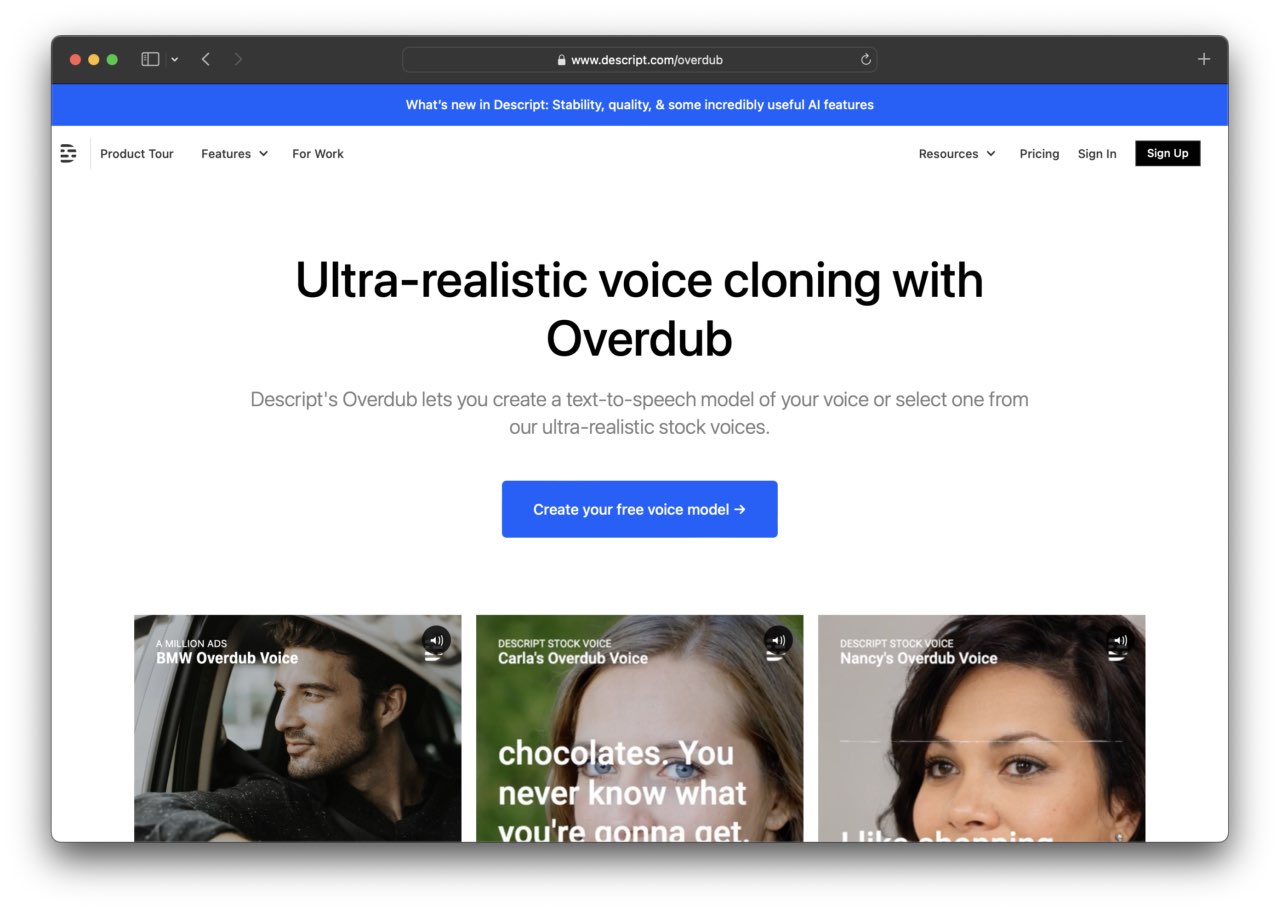 Descript says it uses Lyrebird AI to achieve the “state of the art” in voice synthesis.
Descript says it uses Lyrebird AI to achieve the “state of the art” in voice synthesis.
Writing
An AI rewriter tool uses Artificial Intelligence (AI) to understand the original text’s meaning, such as an article. It rewrites that content based on certain prompts, either from the user or built into the software. This can help with originality, change tone, and make writing more clear and concise.
Some tools are better at preserving the original meaning of a text while changing the wording just enough, while others excel at creating more readable and grammatically correct copies. Many rewriters switch out words with relevant synonyms or paraphrase and rearrange sentences. In most cases, AI rewriters can enhance and polish written content. If you’re suffering from writer’s block, have trouble articulating a specific idea or want to rephrase and rework the structure of your article, AI rewriting tools can offer helpful suggestions.
AI rewriters can create new versions of existing texts, and some can generate entirely new content from simple prompts. They can be valuable tools for SEO writers, businesses, students, and anyone needing to create fresh content efficiently. In fact, some of the best SEO tools use AI to help optimize content.
Copywriting AI tools can help with marketing strategies by generating high-quality content for marketing, product descriptions, and sales copy. There are also AI tools for rewriting existing content to ensure it remains fresh and relevant.
SEO AI tools can use Natural Language Processing (NLP) based on keywords to help create quality SEO content. The best SEO tools already use AI to assist with advanced SEO techniques.
Story and creative writing software can quickly generate innovative ideas and help write illustrative content.
Lastly, proofreading AI tools, such as Grammarly, offer spelling and grammar checks and plagiarism checkers in addition to rewriting tools to ensure content is fit for publishing.
The AI writing assistant software market is expected to grow at a rate of 27% from 2023 to 2030, reaching a market size of $6.5 billion by 2030, according to Verified Market Research.
Dramatron
Alphabet’s DeepMind has developed a “co-writing” AI tool, called Dramatron that can generate character descriptions, plot points, location descriptions and dialog. Luckily, it still requires humans to compile, edit and rewrite what Dramatron comes up with to create a proper script. Think of it like ChatGPT, but with output that you can edit into a blockbuster movie script.
GrammarlyGo
Grammarlyhas used AI to edit writing for years but GrammarlyGo, released in April 2023, is a game-changer. GrammarlyGo can also compose writing, on top of its regular bag of tricks that helps you rewrite sentences that conform to writing and grammar best practices. We’ve noticed that it even corrects a lot of AI-generated output, proving that it is a helpful tool no matter how you create content.
The Mac version of the app watches any text you type in a text box, be it email, a text editor or a WordPress blog post and proceeds to flag text with a colored underline which, when clicked, shows a pop-up with a suggested improvement. While the software can see what’s on your screen when you activate the GrammarlyGo module, Grammarly says the data is anonymized before it’s sent to its grammar-checking engine.
Users get 100 prompts a month free. That goes up to 500 if they pay $30 per month or $144 annually.
 GrammarlyGo is a powerful addition to app’s more mundane spell and grammar checking tools. It rewrites highlighted text, which is a big plus. Unfortunately, it has no facility to add the revised text below the original version, like Notion does.
GrammarlyGo is a powerful addition to app’s more mundane spell and grammar checking tools. It rewrites highlighted text, which is a big plus. Unfortunately, it has no facility to add the revised text below the original version, like Notion does.
Jasper
Everyone raves about Jasper, a popular AI writing platform originally called Jarvis. It is highly marketing-focused, helping users write long articles, SEO content, blog posts, sales emails, and more. It also offers training, courses, and conferences that apparently are also popular among its users. Jasper’s key features include integration with other tools, such as Surfer SEO and Grammarly. It also has its own Chrome extension. More importantly, Jasper has access to the internet, so it helps write more timely stories than ChatGPT. All those features come with a price. Jasper is the most expensive AI writing tool by a long shot.
Jasper costs $49/mo. on the monthly billing plan with a seven-day free trial.
 Jasper is a favorite of marketers. It comes with 50+ templates and has a “Brand Voice” feature, which ensures a consistent writing style.
Jasper is a favorite of marketers. It comes with 50+ templates and has a “Brand Voice” feature, which ensures a consistent writing style.
Rytr
Rytr is an AI-powered writing platform that also offers image generation. It uses a “Use case” with one of the largest footprints of all AI writing tools on the market. It’s an all-purpose AI tool that is handy for any diversified marketer. It has copywriting frameworks, templates for blog writing, and use cases for creating product descriptions for various applications and industries, including marketing, e-commerce, and more. The also offers Rytr Chat, which takes prompt-based commands to generate specific content.
Besides 40+ templates and use cases, there is a dark-mode Chrome extension that brings the power of AI to other apps like WordPress and email. Semrush integration offers keyword research suggestions when using Blog Idea and Blog Outline templates. The company claims that more than 5.5 million people use Rytr, probably due to its free plan. Paid plans are $29/mo.
WriteSonic and ChatSonic
ChatSonic is a GPT-4-powered AI writing assistant developed by Writesonic. It can be used for both text and image creation, and it connects to Google search to generate relevant content. ChatSonic is a GPT-4-powered AI writing assistant that can generate any kind of content, be it blog posts, emails, tweets, posts, product descriptions, ads, etc. Writers can ask ChatSonic questions and receive original, plagiarism-free content that is customized to meet the needs of the writer. Simply type in a prompt or request, and ChatSonic will use its Natural Language Processing (NLP) and machine learning technology to understand even complex requests and provide customized text solutions.
Unfortunately, WriteSonic suffers from a cluttered interface with way too many options to choose from. For example, the Article And Blogs menu features AI Article Writer 5.0, AI Article Writer 4.0, and AI Article Writer 3.0. Don’t ask why.
